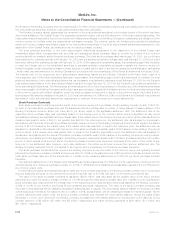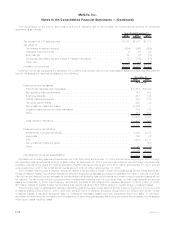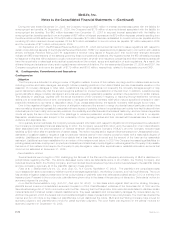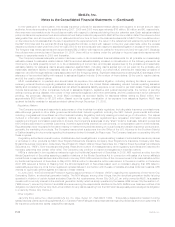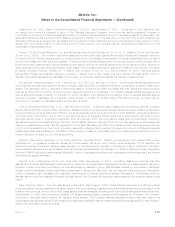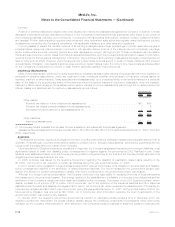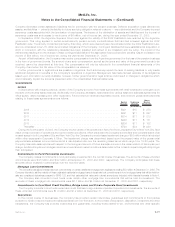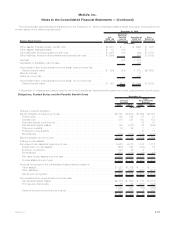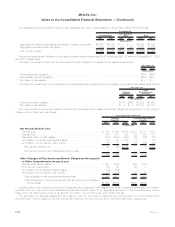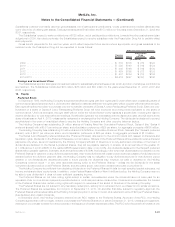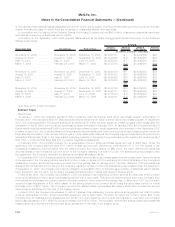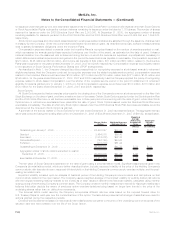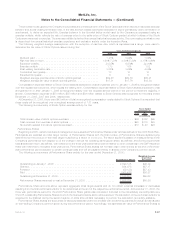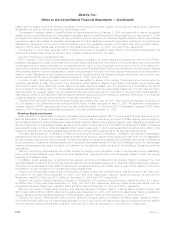MetLife 2008 Annual Report Download - page 201
Download and view the complete annual report
Please find page 201 of the 2008 MetLife annual report below. You can navigate through the pages in the report by either clicking on the pages listed below, or by using the keyword search tool below to find specific information within the annual report.liabilities, and other indemnities and guarantees that are triggered by, among other things, breaches of representations, warranties or
covenants provided by the Company. In addition, in the normal course of business, the Company provides indemnifications to counter-
parties in contracts with triggers similar to the foregoing, as well as for certain other liabilities, such as third party lawsuits. These
obligations are often subject to time limitations that vary in duration, including contractual limitations and those that arise by operation of
law, such as applicable statutes of limitation. In some cases, the maximum potential obligation under the indemnities and guarantees is
subject to a contractual limitation ranging from less than $1 million to $800 million, with a cumulative maximum of $1.6 billion, while in other
cases such limitations are not specified or applicable. Since certain of these obligations are not subject to limitations, the Company does
not believe that it is possible to determine the maximum potential amount that could become due under these guarantees in the future.
Management believes that it is unlikely the Company will have to make any material payments under these indemnities, guarantees, or
commitments.
In addition, the Company indemnifies its directors and officers as provided in its charters and by-laws. Also, the Company indemnifies
its agents for liabilities incurred as a result of their representation of the Company’s interests. Since these indemnities are generally not
subject to limitation with respect to duration or amount, the Company does not believe that it is possible to determine the maximum
potential amount that could become due under these indemnities in the future.
The Company has also guaranteed minimum investment returns on certain international retirement funds in accordance with local laws.
Since these guarantees are not subject to limitation with respect to duration or amount, the Company does not believe that it is possible to
determine the maximum potential amount that could become due under these guarantees in the future.
During the year ended December 31, 2008, the Company recorded $7 million of additional liabilities for guarantees related to certain
investment transactions. The term for these guarantees and their associated liabilities varies, with a maximum of 18 years. The maximum
potential amount of future payments the Company could be required to pay under these guarantees is $202 million. During the year ended
December 31, 2008, the Company reduced $7 million of previously recorded liabilities related to indemnifications provided in connection
with the disposition of real estate property and other investment transactions. The Company’s recorded liabilities were $6 million at both
December 31, 2008 and 2007 for indemnities, guarantees and commitments.
In connection with synthetically created investment transactions, the Company writes credit default swap obligations that generally require payment of
principal outstanding due in exchange for the referenced credit obligation. If a credit event, as defined by the contract, occurs the Company’s maximum
amount at risk, assuming the value of all referenced credits obligations is zero, was $1.9 billion at December 31, 2008. The Company can terminate these
contracts at any time through cash settlement with the counterparty at an amount equal to the then current fair value of the credit default swaps. As of
December 31, 2008, the Company would have paid $37 million to terminate all of these contracts.
See Note 4 for further disclosures related to credit default swap obligations.
17. Employee Benefit Plans
Pension and Other Postretirement Benefit Plans
The Subsidiaries sponsor and/or administer various qualified and non-qualified defined benefit pension plans and other postretirement
employee benefit plans covering employees and sales representatives who meet specified eligibility requirements. Pension benefits are
provided utilizing either a traditional formula or cash balance formula. The traditional formula provides benefits based upon years of credited
service and either final average or career average earnings. The cash balance formula utilizes hypothetical or notional accounts which
credit participants with benefits equal to a percentage of eligible pay, as well as earnings credits, determined annually based upon the
average annual rate of interest on 30-year U.S. Treasury securities, for each account balance. At December 31, 2008, the majority of
active participants are accruing benefits under the cash balance formula; however, approximately 95% of the Subsidiaries’ obligations
result from benefits calculated with the traditional formula. The non-qualified pension plans provide supplemental benefits, in excess of
amounts permitted by governmental agencies, to certain executive level employees.
The Subsidiaries also provide certain postemployment benefits and certain postretirement medical and life insurance benefits for retired
employees. Employees of the Subsidiaries who were hired prior to 2003 (or, in certain cases, rehired during or after 2003) and meet age
and service criteria while working for one of the Subsidiaries, may become eligible for these other postretirement benefits, at various levels,
in accordance with the applicable plans. Virtually all retirees, or their beneficiaries, contribute a portion of the total cost of postretirement
medical benefits. Employees hired after 2003 are not eligible for any employer subsidy for postretirement medical benefits.
As described more fully in Note 1, effective December 31, 2006, the Company adopted SFAS 158. The adoption of SFAS 158 required
the recognition of the funded status of defined benefit pension and other postretirement benefit plans and eliminated the additional
minimum pension liability provision of SFAS 87. The Company’s additional minimum pension liability was $78 million, and the intangible
asset was $12 million, at December 31, 2005. The excess of the additional minimum pension liability over the intangible asset of
$66 million, $41 million net of income tax, was recorded as a reduction of accumulated other comprehensive income. At December 31,
2006, immediately prior to adopting SFAS 158, the Company’s additional minimum pension liability was $92 million. The additional
minimum pension liability of $59 million, net of income tax of $33 million, was recorded as a reduction of accumulated other comprehensive
income. The change in the additional minimum pension liability of $18 million, net of income tax, was reflected as a component of
comprehensive income for the year ended December 31, 2006. Upon adoption of SFAS 158, the Company eliminated the additional
minimum pension liability and recognized as an adjustment to accumulated other comprehensive income (loss), net of income tax, those
amounts of actuarial gains and losses, prior service costs and credits, and the remaining net transition asset or obligation that had not yet
been included in net periodic benefit cost at the date of adoption.
F-78 MetLife, Inc.
MetLife, Inc.
Notes to the Consolidated Financial Statements — (Continued)


